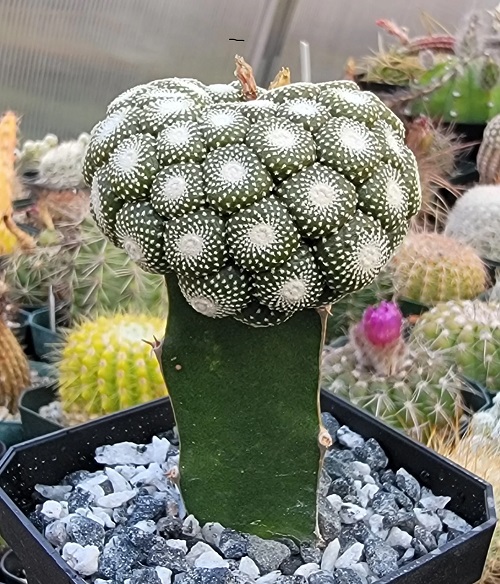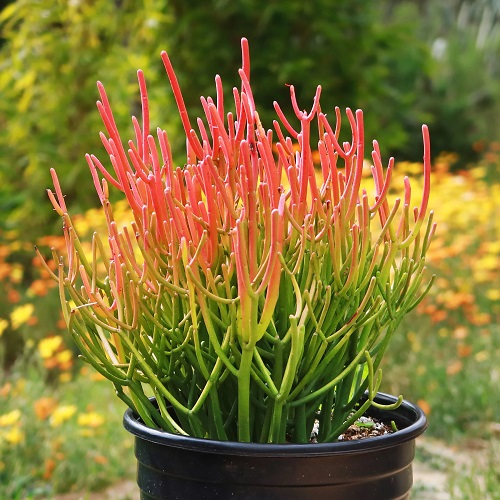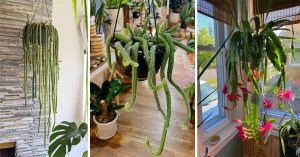Think cacti are all about thorns and spines? We are here to change your mind with our top picks of Spineless Cactus Varieties!
If you love cacti but worry about their prickly thorns accidentally hurting your young ones or pets, our hand-picked spineless cactus varieties are meant just for you! Resilient and easy to grow, our thorn-free list is perfect for novice cacti enthusiasts.
List of Spineless Cactus Varieties
1. Queen of the Night
Botanical Name: Epiphyllum Oxypetalum
The Queen of the Night, a spineless cactus with flat, green, waxy stems that can reach colossal heights of 20 feet, is a rare and endangered species. It is also popular as the Dutchman’s pipe, it produces extraordinary nocturnal blooms around late spring. The large, white, fragrant flowers open up in the night and perish by day, making each bloom a precious sight.
2. Easter Cactus
Botanical Name: Hatiora gaertneri
Native to rainforests, Easter cactus grows as a droopy, branching plant and is famous for its colorful star-shaped blooms. Known as the holiday cactus as well, its spineless body comprises rough-edged cladodes, where stems get flattened and take on the photosynthetic functions of leaves. Preferring humidity, this cactus produces cheerful, hot-pink, star-like blossoms right around Easter!
3. Star Rock Cactus
Botanical Name: Ariocarpus retusus
Resembling a half-buried pineapple, this slow-growing, rosette-forming geophyte sports a flattened, olive-green spherical body with light-colored wool emerging from its furrows. This solitary succulent, mostly camouflaged in its natural surroundings, is thrown into the spotlight due to the light purple and reddish pink blooms it produces around October.
4. Dragon Fruit

Botanical Name: Selenicereus undatus
Surprised? Dragon Fruit is not just any plant but, indeed, a delectable cactus! With scaly pinkish-red skin and seeded white or red flesh, the buds of these crunchy delights grow on spineless cactus vines. Its aerial roots and long stems require trellises to grow and stay erect. Another nocturnal bloomer, this succulent produces gigantic, fragrant, trumpet-like flowers with soft white petals encasing a golden yellow center.
5. Sand Dollar Cactus

Botanical Name: Astrophytum asterias
Often confused for a green ball, the sand dollar is a species of spineless cactus native to Mexico. Reaching up to 6 cm in height, this greenish-brown cross-pollinator sports a fleshy, stout body with star-type segmentations on its dome-like stem. Also known as the star cactus, it produces delicate pale yellow flowers with an orangish-red base and furry exteriors in summer.
6. Peyote

Botanical Name: Lophophora williamsii
The mystical peyote possesses a smooth and fleshy stem, similar to the shape of the star cactus mentioned above. However, the distinguishing factor is a tuft of yellowish hair present on its lower end. This endangered, hallucinogenic succulent is illegal to cultivate in the US except by members of the Native American Church, who use it for ritualistic and religious enlightenment.
7. Spineless Prickly Pear Cactus

Botanical Name: Opuntia cacanapa ‘Ellisiana’
While the name contains the word “prickly,” some varieties of Opuntia contain few or no spines! This cold-hardy succulent was considered an easy-to-grow, high-yielding food option for both humans and livestock. Flowering occurs 2 to 3 years after planting, with its sweet, melony fruits blooming in colors like purple, pink, yellow and red before ripening.
8. Paper Spine Cactus
Botanical Name: Tephrocactus articulatus
Featuring foot-long branching stems with irregular bumps, this species does possess long, white, ribbon-like spines that are considered harmless. However, its areoles possess glochids—tiny barbed spines that can hook onto things it comes in contact with. Irregular and oblong in appearance, its stem segments easily fall off and can be used to propagate new plants.
9. Blossfeldia liliputana
Botanical Name: Blossfeldia liliputana
On a casual stroll, don’t be too sure the tiny, round, textured green pebble on the ground is actually one! The smallest cactus in the world grows up to 1 cm upon maturity, and its rotund green spineless body comprises areolas with white woolly tufts systematically spiraling out. Producing feathery white and pale flowers around spring and summer, ‘space’ can never be the issue when it comes to growing these beauties!
10. Christmas Cactus

Botanical Name: Schlumbergera
It is native to Brazil, the showy Christmas cactus can live up to 100 years! With an appearance unlike typical cacti, this festive houseplant possesses leaf-like, glossy, smooth stems that attach to the tips of one another and produce incredible red and pink blooms.
11. Mistletoe cactus
Botanical Name: Rhipsalis baccifera
Prettiest in hanging baskets, the Mistletoe cactus is an epiphyte with thin, trailing stems. During its early stages, the presence of areoles produces a woolly texture to its stems, but they quickly morph into smooth adults. Also known as chain cactus, this tropical succulent requires partial shade and humidity to thrive.
False Cactus: Euphorbia
Euphorbia is a diverse genus of flowering plants, also called spurge. Succulent euphorbias are often confused for cacti, perhaps due to the similarities they share in growing conditions and, hence, appearance. Excellent garden and house plants, and sturdy like their cacti counterparts, let’s take a look at a few spineless euphorbia varieties for your home.
1. Sticks on Fire
Botanical Name: Euphorbia tirucalli ‘Sticks on Fire’
If you encounter a cluster of tiny tiki torches emerging from the ground, you’ve most likely chanced upon the feisty ‘sticks on fire’ euphorbia. This spineless variety gains its trademark fiery hues when exposed to bright sunlight.
2. Euphorbia pseudocactus
Botanical Name: Euphorbia pseudocactus
This euphorbia has thick, green, and wavy stems with mottled patterns, and is a perfect cactus alternative to grow in small spaces.
3. Spineless Cow’s Horn
Botanical Name: Euphorbia stenoclada Spineless
Native to Madagascar, this tropical succulent features bright silver and greenish-white multi-branched stems that contrast well against typical green foliage.















